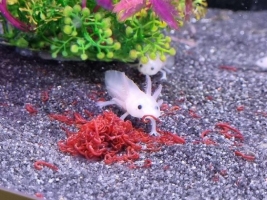The Axolotl is an amphibian and a paedomorphic salamander that shares similar features with the tiger salamander. The word “axolotl” comes from the word “Xolotl”.
According to legend, Xolotl is the Aztec deity of fire and lightning, and he turned himself into a salamander to escape being used as a sacrifice. Its scientific name is Ambystoma mexicanum. In the wild, an axolotl has a lifespan of 10-15 years.
The original habitat of the Axolotl was beneath the Lakes Chalco and Xochimilco in Mexico City. However, Spanish explorers drained this lake during their American conquest and destroyed this organism’s natural habitat. People moved the Axolotl from Mexico to Paris in 11863. Since then, many across Europe have been breeding them as pets.
What Makes Axolotls Physically Unique

Axolotls grow to an average length of 9 inches, with 18 inches being the longest. They have a dark color with silvery highlights on their skin. They have streamlined and broad bodies with big heads and feather-like filaments for gas exchange while underwater. When they surface from the water, they use their lungs to breathe.
They also possess lizard-like limbs, enabling them to move along the bottom of lakes and water bodies. These Amphibians use their eel-like tails to swim in water. Axolotls can reach speeds as high as 15 kilometers per hour.
Where They Thrive in the Wild
At present, it is only possible to find Axolotls in the canals, marshes, swamps, and lakes of Mexico City. With the current degradation from human activities, urbanization, and water pollution, the population of Axolotls in the wild has been decreasing over the years.
These amphibians need a murky water body with soft, muddy bottoms to thrive. Furthermore, they use water plants to hide from potential predators and lay their eggs.
Some of the specific places that they can be found include Lake Chalco, Lake Chapultepec, and Lake Xochimilco in Mexico City. Nevertheless, axolotls exist in captivity in several laboratories and aquariums in Europe, Asia, and North America.
Their Diet and Nutritional Needs

Axolotls are carnivorous amphibians. Some of their prey include insects, small crustaceans, earthworms, bone shrimp, white worms, grind worms, and fish.
For Axolotls being bred in aquariums and breeding programs, it is best to feed adult Axolotls three times a day and young offspring as often as possible. For young Axolotls, live food is preferable. Any excreta or unconsumed food should be removed immediately.
In polluted waters, Axolotls experience increased cloudiness, which decreases their ability to see their prey. Pollution also reduces the oxygen level in water bodies, making it more difficult for Axolotls to survive.
Interesting Facts and Unique Features

There are several interesting facts about Axolotls. One is that they are capable of regrowing body parts. They have been observed to regenerate limbs, hearts, and spinal cords without scarring. For this reason, scientists all over the world have been studying them.
Perhaps they might be the key to helping scientists to slow down aging in humans and develop gene therapies for tissue regeneration. Furthermore, Axolotls don’t undergo complete metamorphosis like other amphibians.
Due to a condition called neoteny, they stay in their larval stage forever while maintaining their external gills. However, some Axolotls can grow into adult salamanders if they are in a stressful environment or receive doses of thyroid hormones.
Axolotls don’t use their teeth to chew prey; they use them to capture the prey. Then, they use a suction force to swallow the food as a whole.
The Fight to Save Axolotls
In the wild, axolotls have a small population, with a particular research group claiming that only 50 – 1000 adults are remaining. As a result, the Mexican government has given these amphibians a protected status as an endangered species. In recent years, ecotourism and sensitization efforts have been made to increase Axolotl populations.

